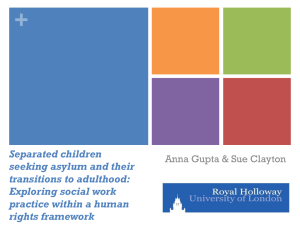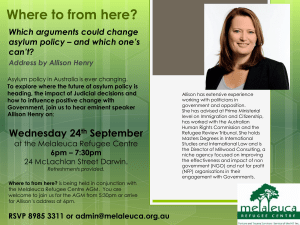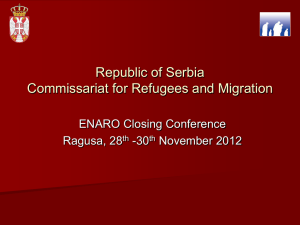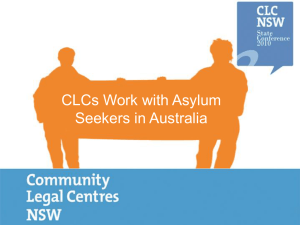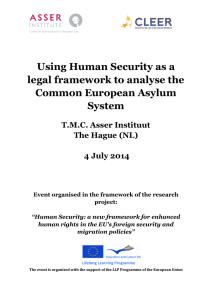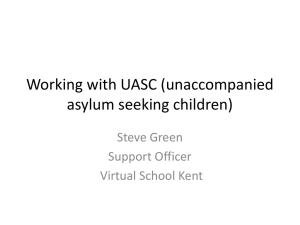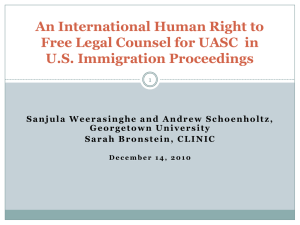Asylum and Age Assessment
advertisement
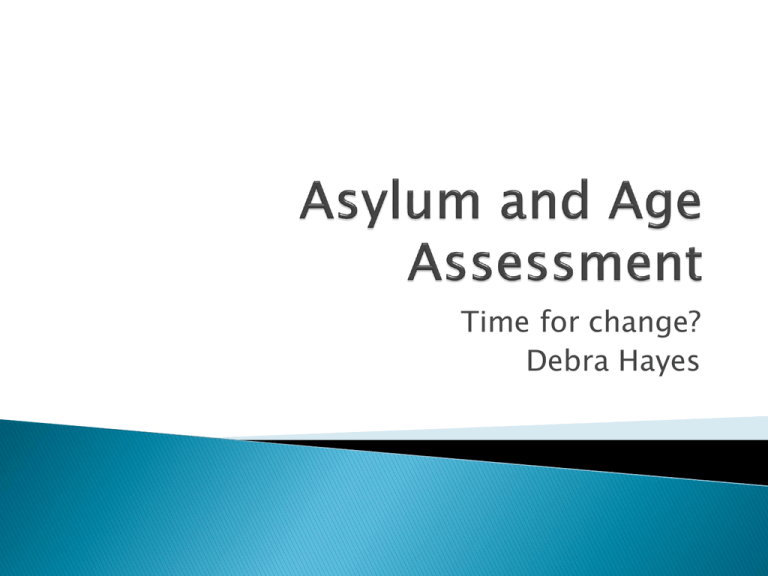
Time for change? Debra Hayes “An unaccompanied asylum seeking child is a person under the age of 18 who is applying for asylum in his/her own right, who is separated from both parents and not being cared for by an adult by law.” There are an estimated 5,500 UASC in the UK Since the year 2000 over 15,000 UASC have entered the UK seeking asylum. They may enter with no ID or documentation An increasing number are being “age disputed”, in 2009 over a 1000. Sources – UNHCR and Refugee Council via redcross.org.uk/refugee Separated children who claim asylum alone (UASC) may need to be age assessed because 1. UKBA need to know if the applicant is over or under 18 because that will determine the support arrangements. Adults enter the asylum system and all that goes with it (dispersal, subsistence living, potential destitution, possibly even detention) whilst children are the responsibility of the Local Authority and will be looked after under the Children Act. 2. The LA has a duty to assess children in need, to do so age is required. Eligibility and entitlements around 16 and 18 differ. Chronological age is not necessarily clear in all cultures and contexts. There may not be records or even a shared understanding of a “birthday”. There are different conventions and calendars. Separated children may not have documentary evidence like birth certificates or identity cards A “culture of disbelief” permeates the asylum system which extends to children. Basically adults are said to be posing as children to “benefit” from advantageous arrangements Even within the same context there are many physical and emotional differences among children We have many Eurocentric ideas about what a child should be able to do at a particular age Separated children come from a complex array of circumstances where they may have had to function independently, had significant caring responsibilities and experienced traumatic events There is NO reliable medical or scientific test to establish chronological age. All methods have a significant margin of error which is why paediatric assessment talk in ranges eg 14-16, rather than a fixed point. Key research by Crawley (2007) found most disputes arise early in the asylum process with UKBA case owners at ports and screening units making a quick assessment based on physical appearance and demeanour. Where the applicant’s appearance “very strongly” suggests they are significantly over 18 they will be age disputed and enter the adult asylum system with all the terrible consequences (dispersal, housing with adults, possible detention and already with credibility compromised and having not been believed) In other cases where the stated age is disbelieved but they are not considered significantly over 18, the young person becomes “age disputed” and will be referred to the LA for formal assessment. The LA will conduct an assessment of age to determine eligibility for services. It may agree or disagree with the original UKBA assessment. Sometimes the LA will dispute even when UKBA didn’t. It may agree the person is a child but still dispute the actual age. Additionally social workers at asylum screening units may undertake age assessments, possibly alongside other screening interviews, raising issues about role and function. The LA may also come into contact with age disputed young people who have been dispersed into their area as adults Some age disputed young people are not formally age assessed in the LA responsible for them Some young people are assessed many times within and between LA’s There is NO statutory guidance. There is a protocol (HO/ADSS 2006) Legal challenges mean since 2003 they should be “Merton-compliant” ie done holistically covering areas such as physical appearance/demeanour, interaction during assessment, social history and family, developmental issues, education, independence and self care, health and medical info and contact with other relevant sources Continued inconsistencies in process, some LA’s have expertise and specialists, some do not. Research indicates considerable inconsistencies in quality. (Crawley, 2007) Judicial Reviews have raised issues about the weight given to “experts” Context of resource constraint and cuts, the LA doing the age assessment is the funding authority Young people may be in protracted battles to get basic protection and services However holistic they are, age assessments often end up making problematic judgements and statements about credibility which ultimately affect the asylum claim In no other arena do we systematically disbelieve young people/children. Rising numbers are being age disputed, in 2009 3,175 UASC applied for asylum and 1,130 were age disputed. Some years it has been almost half of all applications Recent research (Kvittingen, 2010) draws attention to the fact that the age assessment process itself prejudices UASC’s in securing refugee status. (it is always worth remembering that the majority of asylum claims fail, around 70% and UASC’s fare worse than adults in asylum adjudication) Significantly Social Services, unlike in other European countries, have become the “expert” in age assessment, even above paediatrician’s who are technically more neutral. Local Authorities are likely to be increasingly subject to litigation. This cannot be seen outside the context of a hostile asylum system which has the stated intention of deterring, detaining and removing those seeking safety, constructing them as undesirable, socially burdensome and costly, rather than as valuable members of our communities. The context of the cuts means we need to be careful to avoid scapegoating this group who may be considered expensive and less deserving than citizen children. We are becoming increasingly embroiled in immigration systems with lack of clarity about role and function, who are we doing age assessments for? “the cumulative effect of the age assessment process has unintended and unforeseen consequences when evaluating age-disputed UASC’s credibility. As a result, age assessment may ultimately negatively impact asylum adjudication and is therefore likely to remain politicised.” Kvittingen (2010) p.7 Improve training and support in age assessment? Establish statutory guidance and independent review? Developing regional expertise/specialism? Separate the age assessor role from the funding authority? Engage in a campaign of opposition to age assessment in the profession with a view to building a boycott? Crawley,H (2007) When is a child not a child? Asylum, age disputes and the process of age assessment, ILPA Kvittingen,AV (2010) Negotiating childhood: Age assessment in the UK asylum system, Refugee Studies Centre www.redcross.org.uk/refugee
